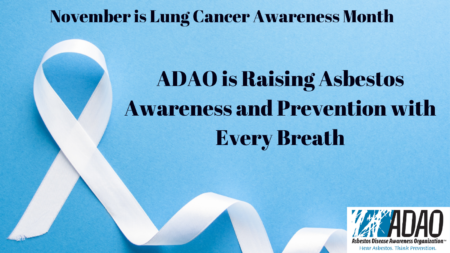Posted October 29, 2022
 November is lung cancer awareness month, and ADAO wants to use this opportunity to shed light on the disease that kills more people than any other form of cancer. From the Lung Cancer Research Foundation, reports show:
November is lung cancer awareness month, and ADAO wants to use this opportunity to shed light on the disease that kills more people than any other form of cancer. From the Lung Cancer Research Foundation, reports show:
- Lung Cancer is the leading cause of cancer death worldwide
- An estimated 236,740 people will be diagnosed with lung cancer in 2022 in the U.S.
- Approximately 130,180 American lives are lost annually
- 1 in 16 people will be diagnosed with lung lacer in their lifetime
- Asbestos is a leading risk factor when it comes to developing lung cancer
Every year, we use October to celebrate Healthy Lung Month and Health Literacy Month. Now, starting on November 1st, we shift our focus to Lung Cancer Awareness Month. Many people are unaware that asbestos, a known carcinogen which is found today in buildings, schools, cosmetics, children’s toys, and more, can damage your lungs and cause cancer. Yet the United States still imports and uses the deadly toxin. There are about 3,000 people diagnosed with mesothelioma each year in the U.S., and asbestos-related lung cancer kills twice as many Americans each year as mesothelioma. In 2017 alone, an estimated 34,000 Americans died from asbestos-caused lung cancer. Asbestos is still legal and lethal in the U.S. today.
Second-hand asbestos exposure can ripple through a community rapidly, proving to be dangerous, deadly, and unstoppable. The fibers of this mineral cling to the clothing and hair of people who work directly with it, making exposure possible for countless others, though most people have no idea they are being exposed. A recent ProPublica article, “Lawsuits: A Factory Blew Asbestos Inot a Neighborhood; Decades Later, Residents Are Getting Sick and Dying,” details the horrifying impacts of asbestos exposure on individuals, their families, and entire communities. There is no safe level of exposure to asbestos, for those who work directly with it, or those that are exposed second-hand.
Additionally, legacy asbestos can be found in millions of buildings around our nation, which can then be released into the air during natural disasters like wildfires, hurricanes, and tornadoes. This puts our first responders and community members in greater danger of asbestos exposure during and long after a disaster.
Therefore, in honor of Lung Cancer Awareness Month, ADAO is presenting five ways in which you can learn more about asbestos and asbestos-related illnesses, advocate for those who have been exposed, and fight for a ban to help save lives.
- Educate yourself: Asbestos can be found in homes, schools, and workplaces. In the first quarter of 2022 alone, the Chlor-alkali industry, the sole importer and user of raw chrysotile asbestos today, imported 114 metric tons of asbestos.
- Quit smoking: Acquire knowledge around smoking cessation programs. While we know smoking is already harmful, those exposed to asbestos are 5 times more likely to get an asbestos-related respiratory disease if they smoke.
- Watch for the early warning signs: A cough that won’t go away, tightness in the chest, wheezing and ongoing shortness of breath may be signs of concern. Try to seek professional medical advice if these symptoms persist. (We of course want to mention you should speak with your physician to discuss COVID symptoms and testing.)
- Aim for Early Detection: If exhibiting the warning signs above, you may consider asking your physician for a low-dose CT scan. These scans are a new and accepted form of screening tests that help improve early detection and treatment. You can learn about them in this video by Dr. Steven Markowitz or by talking with your primary care physician.
- Learn about your diagnosis and treatment options: Lung cancer develops within the lung; however, mesothelioma develops in the mesothelium. Mesothelial tumors can be non-cancerous (benign) or cancerous (malignant mesothelioma). There are four types of mesothelioma: pleural, peritoneal, pericardial and testicular. Both lung cancer and mesothelioma have a poor prognosis. Education on the type of cancer can help determine available treatment options that are right for the patient.
Please consider sharing these five points on your social media accounts, you could save a life! The time to act is now. We are stronger together.
In unity,
Linda Reinstein
